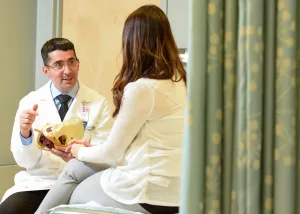Urogynecology is a medical specialty that combines urology and gynecology care to treat conditions like a weak bladder or pelvic organ prolapse. Our goal is to make it easier for women and people assigned female at birth (AFABs) to receive specialized care for the vagina, uterus, bladder and pelvic organs.
What’s the difference between urogynecology and urology?
Urogynecology is dedicated to treating pelvic health concerns specifically for women and AFABs, whereas urology is a more general urinary medical practice that treats all people.
Since every body is different, we take a personalized approach to pelvic health care. Whether you seek relief from a urinary tract infection (UTI), stress incontinence or other conditions affecting your pelvic floor, we’re committed to alleviating symptoms for a more comfortable life.

Conditions
Urogynecological and pelvic floor disorders can take a toll on your day-to-day activities. Know that you can turn to us to treat the following conditions and more:
Although we treat a variety of pelvic health issues, the most common conditions we treat are:
Stress urinary incontinence
Stress urinary incontinence is a type of bladder leakage that happens when you cough, laugh, sneeze, exercise or do anything that puts pressure or stress on your lower abdomen. It develops when the muscles and ligaments that support your urethra become weakened by conditions like:
- Aging
- Childbirth
- Chronic constipation
- Chronic cough
- Genetic factors
- Heavy lifting or straining
- Obesity
- Pregnancy
Stress urinary incontinence symptoms
Stress urinary incontinence affects 10–20% of women and AFABs. We encourage talking with your doctor if you experience any of these symptoms:
- Bladder leakage or urinary incontinence
- Bowel leakage or fecal incontinence
- Feeling like you can’t empty your bladder well
- Leaking with cough, laugh, sneeze or exercise
- Leaking with orgasm or sexual activity
Limiting your physical activity to avoid leaking
Pelvic organ prolapse
Pelvic organ prolapse happens when weakened pelvic muscles cause one or more organs — bladder, rectum, uterus or vagina — to bulge or drop out of place. This condition can affect anyone. For women and AFABs, a prolapse occurs when organs bulge into or out of the vagina. This can be caused by:
- Aging
- Childbirth
- Chronic constipation
- Chronic cough
- Connective tissue diseases
- Heavy lifting or straining
- Obesity
- Pregnancy
There are different types of prolapses, depending on the body part that moves into your vagina:
- Cystocele (bladder)
- Enterocele (small intestine)
- Rectocele (rectum)
- Uterine prolapse (uterus)
- Vaginal vault prolapse (top of the vagina, in people who have had a hysterectomy)
Pelvic organ prolapse symptoms
Don’t delay in speaking with your doctor if you experience any of these symptoms:
- A bulge in your vagina
- Bladder leakage or urinary incontinence
- Bowel leakage or fecal incontinence
- Discomfort during sexual intercourse
- Dullness, heaviness or significant pressure in your vagina
- Feeling like you can’t empty your bladder well
- Feeling like something is falling out of your vagina
Overactive bladder
An overactive bladder causes a sudden and strong need to urinate, leading to frequent trips to the bathroom and sometimes accidents. This happens because the bladder muscles squeeze unexpectedly, even when the bladder isn't full. An overactive bladder can make daily activities difficult and affect your quality of life. This can be caused by:
- Neurological disorders
- Diabetes
- Urinary tract infections (UTIs)
- Hormonal changes
- Bladder abnormalities
- Medications
- Lifestyle factors
- Aging:
- Obesity
Overactive bladder symptoms
We encourage you to speak with your doctor if you experience any of the following symptoms:
- A sudden, strong need to urinate that is difficult to control
- Urinating more often than usual, typically more than eight times in 24 hours
- Waking up more than once during the night to urinate
- Involuntary leakage of urine immediately following an urgent need to urinate
- Inability to delay urination
Testing
To learn more about your pelvic and reproductive organs, we may recommend 1 or several of the following tests:
- Cystoscopy
- Pelvic floor ultrasounds
- Peripheral nerve evaluation for overactive bladder or accidental bowel leakage
- Urodynamic test
Treatments
Urogynecologic treatment options range from simple pelvic floor exercises to minimally invasive surgical options designed to reduce pain, lower the risk of infection and improve recovery time.
When you turn to Tufts Medicine for care, you can expect a treatment plan that balances your preferences and goals with your health history. Your personalized treatment path may include:
Our physical therapists are invested in your recovery. We’ll work with you to reduce your symptoms using a range of pelvic floor physical therapy exercises like:
- Bladder control training
- Electrical stimulation
- Ergonomics and body mechanics training
- Pelvic floor and core exercises
- Massage and myofascial release
- Relaxation techniques
Pelvic floor exercises, or more commonly known as Kegel exercises, are simple squeeze-and-release actions that help strengthen pelvic floor muscles. You may not be able to see the difference Kegels make over time, but you can feel them.
These exercises are very helpful for people with stress urinary incontinence or pelvic organ prolapse. Consistency is key here, and we recommend doing these exercises regularly to manage your condition. If you need help performing these exercises, we can refer you to a physical therapist who will work with you to target and strengthen your Kegel muscles.
Not every urogynecology condition needs surgery. We offer several in-office procedures designed to get you back to your daily life as quickly as possible.
- Bladder Botox® injections
- Posterior tibial nerve stimulation
- Trigger point injections in the pelvic floor muscles
- Pessary insertion
Surgical options
To decide which surgery is best for you, we'll discuss your preferences, goals, and medical history. We'll also look at how severe your condition and symptoms are. The types of surgeries we suggest may include:
- Fistula surgery
- Laparoscopic surgery
- Mesh complication surgeries
- Pelvic reconstructive surgery
- Robotic-assisted laparoscopic surgery
- Sacral neuromodulation
- Sphincteroplasty
- Vaginal surgery
These surgeries are tailored to your body's anatomy and needs:
- Colpocleisis (vaginal closure)
- Colporrhaphy (repairing the front or back walls of the vagina)
- Hysterectomy (removal of the uterus)
- Non-mesh surgery (native tissue)
- Sacrocolpopexy (mesh-augmented)
- Uterine sparing surgeries (hysteropexy)
These procedures help support the bladder neck and urethra:
- Mesh midurethral slings
- Autologous fascia slings (non-mesh slings)
- Laparoscopic Burch urethropexy (non-mesh laparoscopic surgery)
- Urethral bulking

From regular office visits to inpatient stays, find the healthcare you need and deserve close to home.

Meet the doctors and care team devoted to supporting you every step of the way along your path to better health.